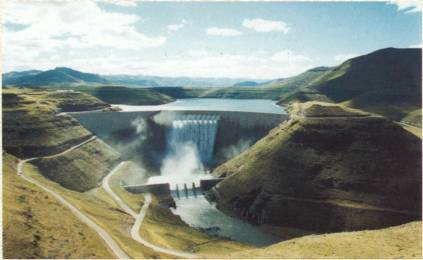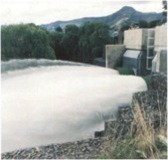| Article: | Description of the Lesotho Highlands Water Project |
|---|---|
| Source: | LHWP Website |
| Date: | July 2002 |
The fundamental purpose of the Lesotho Highlands Water Project (LHWP) is to augment the yield of Vaal Dam reservoir to meet enormous increases in predicted water demand in the industrial hub of Gauteng Province in the Republic of South Africa (RSA).
 The Lesotho Highlands Water
Project is designed to capture and store water in the Maluti Mountains of
Lesotho from where it will be conveyed by gravity through a system of tunnels to
the Ash River Outfall in South Africa. Once in the Ash, the water will follow
the natural river courses and eventually flow into the Vaal Dam reservoir, the
principal source of water for the Province about 70km southeast of Johannesburg.
The Lesotho Highlands Water
Project is designed to capture and store water in the Maluti Mountains of
Lesotho from where it will be conveyed by gravity through a system of tunnels to
the Ash River Outfall in South Africa. Once in the Ash, the water will follow
the natural river courses and eventually flow into the Vaal Dam reservoir, the
principal source of water for the Province about 70km southeast of Johannesburg.
From the conception in the early 1950s, a great deal of effort and persistence culminated in the rigorous negotiation and signing of a bi-national Treaty in October 1986, which has enabled the development of the Project for the mutual benefit of the Republic of South Africa and its independent landlocked neighbour, the Kingdom of Lesotho.
Under the Treaty, the two countries established a Joint Permanent Technical Commission (JPTC) now known as the Lesotho Highlands Water Commission (LHWC) to represent their respective governments during the development of the Project. The LHWC safeguards the provisions of the Treaty, monitors the enormous Project budget, and oversees the activities of the two parastatal organisations established to manage the implementation and operation of the Project in their respective countries. Based in Maseru, the capital of Lesotho, the LHWC comprises three delegates from each country.
The parastatal organisations in each country are: the Trans-Caledon Tunnel Authority (TCTA) in South Africa, established in 1986 through the South African government’s Department of Water Affairs and Forestry (DWAF); and the Lesotho Highlands Development Authority (LHDA) in Lesotho, established by the Lesotho government’s Ministry of Natural Resources.
With more than 90% of the Project located in Lesotho, the task of management for LHDA is extremely demanding. Whereas the TCTA in South Africa operates with relatively small core of about 18 full-time employees, the LHDA staff numbers about 600. Together with the hard core engineers responsibilities, LHDA maintains a large Environmental Management and Public Affairs Department to inform Lesotho citizens about the Project and to help protect their interests, particularly for those directly affected by the project activity. The work of the LHDA also includes implementation of the Rural Development Plan and Public Health Programme, which through the compressive Environmental Action Plan, aims to ensure adequate compensation for people affected by the Project and optimum benefit for the nation as a whole.
 To take advantage of benefits,
South Africa negotiated the Lesotho in 1980’s through the Lesotho Highlands
Water Project Treaty whereby it secured the right to build - at its own cost -
the facilities needed to impound water in the Highlands and transfer it by
gravity to the Vaal. In return Lesotho would receive a schedule of royalties
from South Africa as its share of the net benefits.
To take advantage of benefits,
South Africa negotiated the Lesotho in 1980’s through the Lesotho Highlands
Water Project Treaty whereby it secured the right to build - at its own cost -
the facilities needed to impound water in the Highlands and transfer it by
gravity to the Vaal. In return Lesotho would receive a schedule of royalties
from South Africa as its share of the net benefits.
By design, the Lesotho Highlands Water scheme is a ‘closed’ system. All water entering the Katse Intake Tower must pass through to South Africa. As a consequence, the flow of water and the associated royalty payments are governed solely by the storage and yield capacity of the Katse reservoir. Under the terms of the Treaty therefore, and a complex set of formulae, the royalties payable by South Africa to Lesotho cover both the storage of a committed volume of water in Lesotho and the delivery of a fixed minimum amount of water which increases each year from a minimum commitment of 57 million m3 in the first year of operation to a total of 2,208 million m3 in 2020 and thereafter. A fixed indexed-linked annuity of R7.76 million/month is payable until all project costs have been redeemed and Lesotho’s share of the net benefit has been paid for in full. The royalty of 18.20 cents for each cubic metre of water delivered will continue for the lifetime of the project to cover operating and maintenance costs.
In addition to cost effective gravity feed, South Africa will also benefit immensely from the annual rainfall in the mountains of Lesotho which is significantly more reliable and abundant than in most parts of its own country. Also, the pure quality of the Highlands water will greatly improve the overall quality of the water in the existing Vaal reservoir.
A major benefit to Lesotho will be the ability to generate hydroelectricity as part of the water transfer process. This will end Lesotho’s need to import electricity from South Africa, constituting a substantial national saving. Of equal importance will be the national income accrued from the royalties. Initially, these royalties will amount to about US$28 million per year, including various adjustments for the inflation and other financial considerations. This is about M100 million per year and represents about 4 to 5% of Lesotho’s gross national product, which at present stands at about M2 billion per year.
But while South Africa knew it must wait for commissioning of the current works before it could begin to enjoy the benefits, Lesotho was already enjoying significant economic development as a direct result of the Project and its activities. The Kingdom has gained significantly from the large amounts of Project-related capital invested in the country to date, as well as from the direct and indirect employment and training opportunities created by the Project for its people.
In addition, the tiny Kingdom of
Lesotho has acquired increased international recognition as the host of this
immense civil engineering project. In the long term the Kingdom will benefit
from the continued investment should future phases go ahead, and from the
commercial and tourism opportunities made possible as a direct or indirect
result of the Project.
and from the
commercial and tourism opportunities made possible as a direct or indirect
result of the Project.
The first phase of this ambitious long-term master plan was scheduled for completion in 1996. Phase 1A was designed to deliver 18m3/s of water to South Africa as well as generate 72MW of hydroelectricity for Lesotho. It included construction of two dams, excavation of 82km of about 5m-diameter tunnel and construction of an underground power station.
By the year 2000, the Gauteng Province was expected to accommodate 42% of South Africa’s population and would generate 56% of all industrial and 79% of all mining output. It was expected that the population of the Province supply area and the Vaal River supply area down stream of the Vaal Dam would increase at the rate of 2.4%per year from 5.75 million in 1980 to almost 12 million by the year 2010. This represents an increase of 106%. The corresponding domestic and industrial water demand is expected to increase from 979 million m3 to 3803 million m3 per year, an average annual growth rate of 4.6%. Phase 1A of the Highland’s project will secure a reliable supply of water to the Province region to the year 2004 when the then 7 million population is expected to increase to 10.5 million.
Quick Info.:
Travel and Accommodation
Tourist Attractions
Business Opportunities
Similar Websites